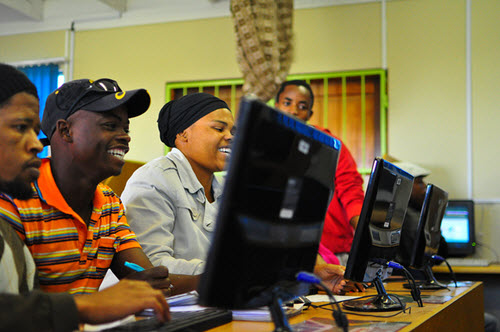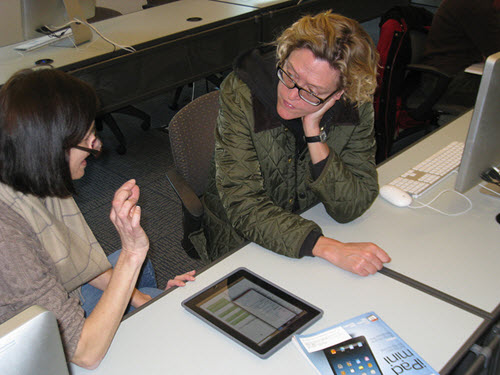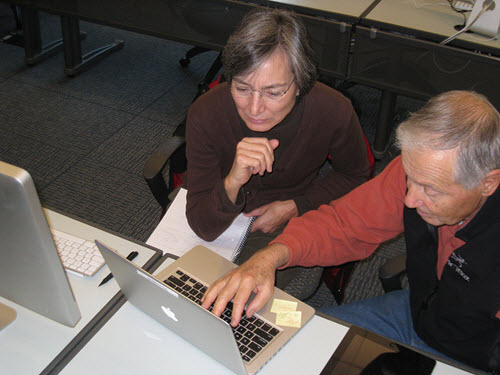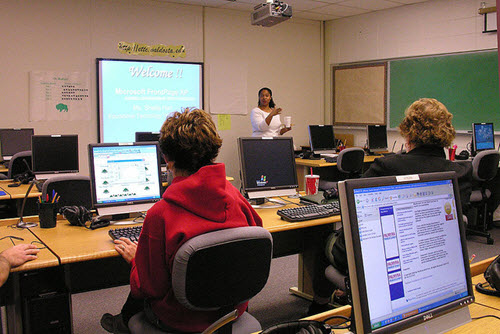Learn by Doing: Teaching Tech to Patrons
 Teaching technology can be daunting. But anyone can become a better technology trainer, says Crystal Schimpf, Library Training Consultant and Kixal CEO. In the recent WebJunction webinar, Top Ten Skills for Teaching Tech to Patrons, Schimpf shared ten clear, down-to-earth technology training tips – and left participants raving. Thanks to ALA's Learning Round Table for hosting this webinar in collaboration with WebJunction.org.
Teaching technology can be daunting. But anyone can become a better technology trainer, says Crystal Schimpf, Library Training Consultant and Kixal CEO. In the recent WebJunction webinar, Top Ten Skills for Teaching Tech to Patrons, Schimpf shared ten clear, down-to-earth technology training tips – and left participants raving. Thanks to ALA's Learning Round Table for hosting this webinar in collaboration with WebJunction.org.
Don't focus on the technology – focus on the teaching
In Schimpf's experience, it's often not the technology part of the equation that is the greatest challenge in teaching technology – instead, it's the teaching part. One of the best ways to become a more effective teacher is to reflect on our experiences as a learner. Chances are, someone has helped you learn something new about technology recently. What worked? As reported by webinar participants, successful tech learning experiences were marked by hands-on time to explore and play, learning from someone who was passionate about the topic, and not feeling embarrassed about their lack of knowledge.
It takes skill to support this type of successful learning. Schimpf has distilled five skills that are particularly useful when providing technology training one-on-one; and five skills that are most helpful for training groups.
One-on-one technology instruction: Five essential skills
 One-on-one instruction can happen anywhere, anytime. You may be on the library floor, or answering a casual question at the desk, staffing a drop-in lab, or in a dedicated book-a-librarian appointment. There is often no time to prepare. For more successful learning outcomes during one-on-one interactions, practice these five skills.
One-on-one instruction can happen anywhere, anytime. You may be on the library floor, or answering a casual question at the desk, staffing a drop-in lab, or in a dedicated book-a-librarian appointment. There is often no time to prepare. For more successful learning outcomes during one-on-one interactions, practice these five skills.
- Be welcoming. Make people who are learning technology feel that they did the right thing by asking for your help. We often inadvertently react to learners' technology questions through the lens of our own fear or maybe even distaste for the topic. Instead, set the learner at ease by smiling and walking over to where they are in the library. If the learner is seated at a computer, crouch or grab a chair to be at their level instead of standing above them. Spend a moment to get to know the person; it may inform your instruction techniques in important ways.
- Assess the need. Think about the learner's need in two ways. First, what are they trying to learn? Second, how will they learn most effectively? Avoid jumping to conclusions about what the person needs or wants to do with technology. Clarify the learner's need or goal with questions like "What would you like to be able to do through my help?" or "What would you like to learn today?" After understanding the need, take a moment to determine the learners' interests or hobbies. This will help you use relevant examples, such as how to get live updates about their favorite sports team.
- Give up control. As hard as it may be—especially when pressed for time—it's critical to let the learner be in control of the computer or device. Giving control to the learner has more benefits than just increasing their familiarity with the technology. This seemingly small act empowers that person to lead the conversation and lets their needs drive instruction. If learners are reluctant to drive, provide extra encouragement. Supporting reluctant learners gets easier with practice. "Most people learn technology by doing, not by watching."
 Be present. Focus as completely as possible on the learner and their need, including paying attention to non-verbal cues. All of us know how maintain focus from other areas of our lives, Schimpf reminds us. Webinar participants shared a flood of examples of non-work situations requiring complete focus: parenting, riding a mountain bike, quilting, cooking, playing an instrument, and training a puppy, to name a few. As technology trainers, we can draw on those experiences of how to be fully present.
Be present. Focus as completely as possible on the learner and their need, including paying attention to non-verbal cues. All of us know how maintain focus from other areas of our lives, Schimpf reminds us. Webinar participants shared a flood of examples of non-work situations requiring complete focus: parenting, riding a mountain bike, quilting, cooking, playing an instrument, and training a puppy, to name a few. As technology trainers, we can draw on those experiences of how to be fully present.- Take it slow. Be patient and mindful of the pace of your interaction, and remember that lots of people learn technology best one step at a time. Be deliberate about selecting the most essential points to cover. To help make sure you're starting in the right place, practice different ways of ask the patron what they already know, with questions like "Can you tell me what you've already done?" or "Where are you getting stuck?"
Along with the great aspects of working with people one-on-one come some challenges. How can you carve out time for meaningful tech instruction opportunities when you're the only person at the desk? Some libraries schedule "book-a-librarian" appointments for quieter times early in the day, sometimes even before the library opens. Other libraries have had good luck with recruiting tech volunteers to help extend staff capacity. Another challenge with one-on-one learning can be setting boundaries with learners who perceive library staff as their own dedicated technology tutor. In these situations, try taking five minutes to help someone get started, and then coming back later to check on them. Referring people to self-paced technology learning options such as mousercize, GCFLearnFree and DigitalLearn may be another good option to help people build skills independently. Even when the library is very busy, practice talking with learners so that they still know that they are a priority.
Group technology instruction: Five essential skills
 Group training aims to share the same content with an entire group, usually focused on a single topic. Several webinar participants shared that they are less comfortable leading group technology training than working one-on-one, primarily because of the wide range of skill level and experience often represented in a group. Try these five skills to help facilitate effective learning in group settings.
Group training aims to share the same content with an entire group, usually focused on a single topic. Several webinar participants shared that they are less comfortable leading group technology training than working one-on-one, primarily because of the wide range of skill level and experience often represented in a group. Try these five skills to help facilitate effective learning in group settings.
- Set the space up for learning. Whether or not you have a dedicated classroom or a computer lab, work with the space you have to create an environment that encourages learning. Schimpf has seen many creative solutions to space restrictions, including holding classes after hours using public access computers on the library floor or converting a small storage room into a tiny classroom. Whatever your learning space may be, maximize comfort by attending to lighting, signage, and temperature. Ensure that people can see and hear and can get in and out of their seats as easily as possible. Early in the training, explain the session plan and set expectations about when to ask questions – this helps put people at ease.
- Communicate clearly. Clear communication is always essential, but it's even more important in technology instruction because of the abstract concepts and how easy it is to slip into technical jargon. For someone just learning about technology, the language can be overwhelming: browser, window, double click, bandwidth, search engine, address bar, link, cursor, upload, download. Try to keep it simple; learners don't need to understand every about computers to use one successfully.
- Involve learners. Deviating from your prepared curriculum may feel risky, but it's worth taking the leap. Ask participants what they most want to learn, and do what you can to balance the content you've prepared with the topics they prioritize most. Addressing learners' interests will help motivate and engage them. Build in interactive activities and discussion to help learners remember the skills they are developing. Most learners don't just want to understand technology – they really want to know how to use it.
 Stay balanced. Teaching a class about technology means being ready for anything, including the library's wifi dropping out. To manage this uncertainty, Schimpf advises thinking about technology instruction as if you are surfing. "Every time you teach, it's like going out to catch a wave. You aren't quite sure what that wave is going to look like, how big it's going to be. . . but the goal is to ride the wave as long as possible without falling off your surfboard." If you find that you've been thrown you off balance, don't worry – just give yourself time to rest and try again. To address unexpected situations or technology glitches, Schimpf sometimes gives learners an unplanned independent practice opportunity while she attends to the issue.
Stay balanced. Teaching a class about technology means being ready for anything, including the library's wifi dropping out. To manage this uncertainty, Schimpf advises thinking about technology instruction as if you are surfing. "Every time you teach, it's like going out to catch a wave. You aren't quite sure what that wave is going to look like, how big it's going to be. . . but the goal is to ride the wave as long as possible without falling off your surfboard." If you find that you've been thrown you off balance, don't worry – just give yourself time to rest and try again. To address unexpected situations or technology glitches, Schimpf sometimes gives learners an unplanned independent practice opportunity while she attends to the issue.- Assign practice. Dedicated practice time, both during and after class, is essential for learners to bring their new skills to life. According to Schimpf, "Practice time is when most learning takes place." Real-life follow-up assignments at the end of class give learners an idea of what to do next and encourage them to keep exploring. In-class practice time has the added benefit of giving the instructor time to work directly with anyone who is behind. Good practice exercises should be simple and based off your best guess of what the learner is going to want to be able to do. If you've just taught a class on email, suggest that learners email five friends in the next week.
Every interaction is an opportunity for learning and teaching
Regardless of the setting, Schimpf encourages approaching technology training as a collaboration with the learner. This resonated with many webinar participants, who shared that they often are learning alongside their "students." In the words of one webinar attendee, "If a question arises that you don't know the answer to, take it as an opportunity to explore it with the learner. You don't have to know everything about technology in order to help the learner accomplish their goals."
Watch the complete archive and explore additional resources on the webinar archive page.
